Papers by Meow-Keong Thong

Human Genetics
Genomic medicine aims to improve health using the individual genomic data of people to inform car... more Genomic medicine aims to improve health using the individual genomic data of people to inform care. While clinical utility of genomic medicine in many monogenic, Mendelian disorders is amply demonstrated, clinical utility is less evident in polygenic traits, e.g., coronary artery disease or breast cancer. Polygenic risk scores (PRS) are subsets of individual genotypes designed to capture heritability of common traits, and hence to allow the stratification of risk of the trait in a population. We systematically reviewed the PubMed database for unequivocal evidence of clinical utility of polygenic risk scores, using stringent inclusion and exclusion criteria. While we identified studies demonstrating clinical validity in conditions where medical intervention based on a PRS is likely to benefit patient outcome, we did not identify a single study demonstrating unequivocally such a benefit, i.e. clinical utility. We conclude that while the routine use of PRSs hold great promise, translat...
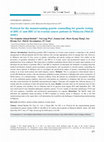
Introduction: Identifying germline BRCA mutations in ovarian cancer patients is important in the... more Introduction: Identifying germline BRCA mutations in ovarian cancer patients is important in the medical management of affected patients and for their relatives who can take appropriate action to manage their risk. However, in Malaysia and most of Asia, access to genetic counselling and genetic testing are limited. Few studies on the prevalence of germline alterations in BRCA1 and BRCA2 in ovarian cancer and psychosocial aspects in an Asian population have been conducted. This study aims to establish a population-based cohort of ovarian cancer patients to (a) determine the prevalence of germline BRCA1 and BRCA2 mutations (b) determine the feasibility of training front-line medical practitioners (namely gynae-oncologists, gynaecologists, and oncologists) to provide genetic counselling for ovarian cancer patients in Malaysia and (c) investigate the psychosocial impact of genetic counselling and genetic testing in an Asian multi-cultural and multi-religious context. Methods: This is...
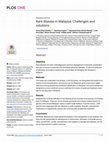
PLOS ONE, 2020
Objective Rare diseases are often underdiagnosed, and their management is frequently complicated ... more Objective Rare diseases are often underdiagnosed, and their management is frequently complicated by a lack of access to treatment and information about the diseases. To allow for better policy planning, we sought to examine the current status of managing rare diseases in Malaysia. Methods This study was conducted in two phases. In the first phase, we triangulated information from reviews of journal publications, documents from the Malaysian government and in-depth interviews among selected key healthcare stakeholders in Malaysia. The second phase was designed as a cross-sectional survey to estimate the number of cases and treatment coverage for rare diseases in Malaysia. Results Malaysia has no official definition of rare disease yet but currently in the process of reviewing them for Malaysia. There are 13 rare disease specialists and a dozen medical doctors in genetic clinics around Malaysia, mainly in public health facilities. From the survey, 1,249 patients were diagnosed with rare diseases in public hospitals. Only 60% received their medications or supplements, and the rest continued with symptomatic treatment. Conclusion Generally, Malaysia has made significant progress in the management of rare diseases, but there are still opportunities for development in critical areas. Ultimately, if all healthcare providers, government, society, and politicians work together to manage rare diseases, we will see an improvement in patient outcomes.
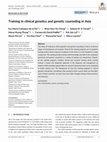
American Journal of Medical Genetics Part C: Seminars in Medical Genetics, 2019
The status of training in clinical genetics and genetic counseling in Asia is at diverse stages o... more The status of training in clinical genetics and genetic counseling in Asia is at diverse stages of development and maturity. Most of the training programs are in academic training centers where exposure to patients in the clinics or in the hospital is a major component. This setting provides trainees with knowledge and skills to be competent geneticists and genetic counselors in a variety of patient care interactions. Majority of the training programs combine clinical and research training which provide trainees a broad and integrated approach in the diagnosis and management of patients while providing opportunities for research discoveries that can be translated to better patient care. The background on how the training programs in clinical genetics and genetic counseling in Asia evolved to their current status are described.
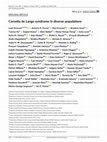
American Journal of Medical Genetics Part A, 2019
syndrome (CdLS) is a dominant multisystemic malformation syndrome due to mutations in five genes-... more syndrome (CdLS) is a dominant multisystemic malformation syndrome due to mutations in five genes-NIPBL, SMC1A, HDAC8, SMC3, and RAD21. The characteristic facial dysmorphisms include microcephaly, arched eyebrows, synophrys, short nose with depressed bridge and anteverted nares, long philtrum, thin lips, micrognathia, and hypertrichosis. Most affected individuals have intellectual disability, growth deficiency, and upper limb anomalies. This study looked at individuals from diverse populations with both clinical and molecularly confirmed diagnoses of CdLS by facial analysis technology. Clinical data and images from 246 individuals with CdLS were obtained from 15 countries. This cohort included 49% female patients and ages ranged from infancy to 37 years. Individuals were grouped into ancestry categories of African descent, Asian, Latin American, Middle Eastern, and Caucasian. Across these populations, 14 features showed a statistically significant difference. The most common facial features found in all ancestry groups included synophrys, short nose with anteverted nares, and a long philtrum with thin vermillion of the upper lip. Using facial analysis technology we compared 246 individuals with CdLS to 246 gender/age matched controls and found that sensitivity was equal or greater than 95% for all groups. Specificity was equal or greater than 91%. In conclusion, we present consistent clinical findings from global populations with CdLS while demonstrating how facial analysis technology can be a tool to support accurate diagnoses in the clinical setting. This work, along with prior studies in this arena, will assist in earlier detection, recognition, and treatment of CdLS worldwide.
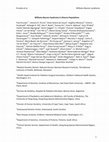
American journal of medical genetics. Part A, 2018
Williams-Beuren syndrome (WBS) is a common microdeletion syndrome characterized by a 1.5Mb deleti... more Williams-Beuren syndrome (WBS) is a common microdeletion syndrome characterized by a 1.5Mb deletion in 7q11.23. The phenotype of WBS has been well described in populations of European descent with not as much attention given to other ethnicities. In this study, individuals with WBS from diverse populations were assessed clinically and by facial analysis technology. Clinical data and images from 137 individuals with WBS were found in 19 countries with an average age of 11 years and female gender of 45%. The most common clinical phenotype elements were periorbital fullness and intellectual disability which were present in greater than 90% of our cohort. Additionally, 75% or greater of all individuals with WBS had malar flattening, long philtrum, wide mouth, and small jaw. Using facial analysis technology, we compared 286 Asian, African, Caucasian, and Latin American individuals with WBS with 286 gender and age matched controls and found that the accuracy to discriminate between WBS an...
American journal of medical genetics. Part A, 2017
The cover image, by Paul Kruszka et al., is based on the Original Article Noonan Syndrome in Dive... more The cover image, by Paul Kruszka et al., is based on the Original Article Noonan Syndrome in Diverse Populations, DOI: 10.1002/ajmg.a.38362. Design Credit: Darryl Leja.
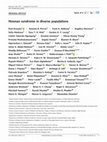
American journal of medical genetics. Part A, Jan 27, 2017
Noonan syndrome (NS) is a common genetic syndrome associated with gain of function variants in ge... more Noonan syndrome (NS) is a common genetic syndrome associated with gain of function variants in genes in the Ras/MAPK pathway. The phenotype of NS has been well characterized in populations of European descent with less attention given to other groups. In this study, individuals from diverse populations with NS were evaluated clinically and by facial analysis technology. Clinical data and images from 125 individuals with NS were obtained from 20 countries with an average age of 8 years and female composition of 46%. Individuals were grouped into categories of African descent (African), Asian, Latin American, and additional/other. Across these different population groups, NS was phenotypically similar with only 2 of 21 clinical elements showing a statistically significant difference. The most common clinical characteristics found in all population groups included widely spaced eyes and low-set ears in 80% or greater of participants, short stature in more than 70%, and pulmonary stenos...
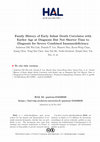
Frontiers in immunology, 2017
Severe combined immunodeficiency (SCID) is fatal unless treated with hematopoietic stem cell tran... more Severe combined immunodeficiency (SCID) is fatal unless treated with hematopoietic stem cell transplant. Delay in diagnosis is common without newborn screening. Family history of infant death due to infection or known SCID (FH) has been associated with earlier diagnosis. The aim of this study was to identify the clinical features that affect age at diagnosis (AD) and time to the diagnosis of SCID. From 2005 to 2016, 147 SCID patients were referred to the Asian Primary Immunodeficiency Network. Patients with genetic diagnosis, age at presentation (AP), and AD were selected for study. A total of 88 different SCID gene mutations were identified in 94 patients, including 49 IL2RG mutations, 12 RAG1 mutations, 8 RAG2 mutations, 7 JAK3 mutations, 4 DCLRE1C mutations, 4 IL7R mutations, 2 RFXANK mutations, and 2 ADA mutations. A total of 29 mutations were previously unreported. Eighty-three of the 94 patients fulfilled the selection criteria. Their median AD was 4 months, and the time to di...
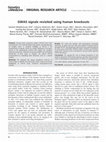
Genetics in medicine : official journal of the American College of Medical Genetics, Jan 22, 2017
PurposeGenome-wide association studies (GWAS) have been instrumental to our understanding of the ... more PurposeGenome-wide association studies (GWAS) have been instrumental to our understanding of the genetic risk determinants of complex traits. A common challenge in GWAS is the interpretation of signals, which are usually attributed to the genes closest to the polymorphic markers that display the strongest statistical association. Naturally occurring complete loss of function (knockout) of these genes in humans can inform GWAS interpretation by unmasking their deficiency state in a clinical context.MethodsWe exploited the unique population structure of Saudi Arabia to identify novel knockout events in genes previously highlighted in GWAS using combined autozygome/exome analysis.ResultsWe report five families with homozygous truncating mutations in genes that had only been linked to human disease through GWAS. The phenotypes observed in the natural knockouts for these genes (TRAF3IP2, FRMD3, RSRC1, BTBD9, and PXDNL) range from consistent with, to unrelated to, the previously reported ...

Journal of genetic counseling, Jan 11, 2017
The Professional Society of Genetic Counselors in Asia (PSGCA) was recently established as a spec... more The Professional Society of Genetic Counselors in Asia (PSGCA) was recently established as a special interest group of the Asia Pacific Society of Human Genetics. Fostering partnerships across the globe, the PSGCA's vision is to be the lead organization that advances and mainstreams the genetic counseling profession in Asia and ensures individuals have access to genetic counseling services. Its mission is to promote quality genetic counseling services in the region by enhancing practice and curricular standards, research and continuing education. The PSGCA was formally launched during the Genetic Counseling Pre-Conference Workshop held at the 11th Asia-Pacific Conference on Human Genetics in Hanoi, Viet Nam, September 16, 2015. The pre-conference workshop provided an opportunity for medical geneticists and genetic counselors from across 10 Asia Pacific countries to learn about the varied genetic counseling practices and strategies for genetic counseling training. This paper prov...

BMJ open, Jan 31, 2017
The lack of epidemiological data and molecular diagnostic services in Malaysia has hampered the s... more The lack of epidemiological data and molecular diagnostic services in Malaysia has hampered the setting-up of a comprehensive management plan for patients with myotonic dystrophy type 1 (DM1), leading to delayed diagnosis, treatment and support for patients and families. The aim of this study was to estimate the prevalence of DM1 in the 3 major ethnic groups in Malaysia and evaluate the feasibility of a single tube triplet-primed PCR (TP-PCR) method for diagnosis of DM1 in Malaysia. We used PCR to determine the size of CTG repeats in 377 individuals not known to be affected by DM and 11 DM1 suspected patients, recruited from a tertiary hospital in Kuala Lumpur. TP-PCR was performed on selected samples, followed by Southern blot hybridisation of PCR amplified fragments to confirm and estimate the size of CTG expansion. The number of individuals not known to be affected by DM with (CTG)>18 was determined according to ethnic group and as a whole population. The χ(2) test was perform...

American journal of medical genetics. Part A, 2017
22q11.2 deletion syndrome (22q11.2 DS) is the most common microdeletion syndrome and is underdiag... more 22q11.2 deletion syndrome (22q11.2 DS) is the most common microdeletion syndrome and is underdiagnosed in diverse populations. This syndrome has a variable phenotype and affects multiple systems, making early recognition imperative. In this study, individuals from diverse populations with 22q11.2 DS were evaluated clinically and by facial analysis technology. Clinical information from 106 individuals and images from 101 were collected from individuals with 22q11.2 DS from 11 countries; average age was 11.7 and 47% were male. Individuals were grouped into categories of African descent (African), Asian, and Latin American. We found that the phenotype of 22q11.2 DS varied across population groups. Only two findings, congenital heart disease and learning problems, were found in greater than 50% of participants. When comparing the clinical features of 22q11.2 DS in each population, the proportion of individuals within each clinical category was statistically different except for learning...
American journal of medical genetics. Part A, 2017
The cover image, by Paul Kruszka et al., is based on the Original Article 22q11.2 deletion syndro... more The cover image, by Paul Kruszka et al., is based on the Original Article 22q11.2 deletion syndrome in diverse populations, DOI: 10.1002/ajmg.a.38199. Individual images are property of the National Human Genome Research Institute and are in the public domain.
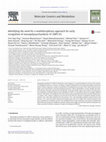
Molecular Genetics and Metabolism, 2015
Lamy syndrome) is caused by deficient activity of the enzyme, N-acetylgalactosamine-4-sulfatase, ... more Lamy syndrome) is caused by deficient activity of the enzyme, N-acetylgalactosamine-4-sulfatase, resulting in impaired degradation of the glycosaminoglycan dermatan sulfate. Patients experience a range of manifestations including joint contractures, short stature, dysostosis multiplex, coarse facial features, decreased pulmonary function, cardiac abnormalities, corneal clouding and shortened life span. Recently, clinicians from institutions in the Asia-Pacific region met to discuss the occurrence and implications of delayed diagnosis and misdiagnosis of MPS VI in the patients they have managed. Eighteen patients (44% female) were diagnosed. The most common sign presented by the patients was bone deformities in 11 patients (65%). Delays to diagnosis occurred due to the lack of or distance to diagnostic facilities for four patients (31%), alternative diagnoses for two patients (15%), and misleading symptoms experienced by two patients (15%). Several patients experienced manifestations that were subtler than would be expected and were subsequently overlooked. Several cases highlighted the unique challenges associated with diagnosing MPS VI from the perspective of different specialties and provide insights into how these patients initially present, which may help to elucidate strategies to improve the diagnosis of MPS VI.
The Medical journal of Malaysia, 2010
We report the first two Malaysian children with partial deletion 9p syndrome, a well delineated b... more We report the first two Malaysian children with partial deletion 9p syndrome, a well delineated but rare clinical entity. Both patients had trigonocephaly, arching eyebrows, anteverted nares, long philtrum, abnormal ear lobules, congenital heart lesions and digital anomalies. In addition, the first patient had underdeveloped female genitalia and anterior anus. The second patient had hypocalcaemia and high arched palate and was initially diagnosed with DiGeorge syndrome. Chromosomal analysis revealed a partial deletion at the short arm of chromosome 9. Karyotyping should be performed in patients with craniostenosis and multiple abnormalities as an early syndromic diagnosis confers prognostic, counselling and management implications.
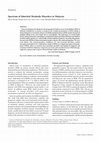
Annals of the Academy of Medicine, Singapore, 2008
Issues pertaining to the diagnosis and management of inborn errors of metabolism (IEM) in Malaysi... more Issues pertaining to the diagnosis and management of inborn errors of metabolism (IEM) in Malaysia included low awareness of atypical and variable presentations in IEMs leading to delayed diagnosis or treatment, absence of reliable population data on IEMs and involvement of multiple siblings in the same family due to consanguinity. The importance of careful family history taking and genetic counselling are emphasised. Selected testing of ill infants and children for IEM yielded a positive 2% (264/13,500) results for IEMs in Malaysia. Out of the 264 patients, the spectrum of IEMs in Malaysia included organic acidurias (98), aminoacidopathies (78), urea cycle defects (54), neurotransmitter conditions (12) and lysosomal disorders, mainly mucopolysaccharidosis (14). Confirmatory studies of IEMs are an important aspect of management of IEMs. There is a need for more metabolic specialists and funding for diagnosis and treatment of IEMs in Malaysia. Long-term care issues and cost-effective...
The Medical journal of Malaysia, 1996
The finding of a supernumerary or marker chromosome in a karyotype poses difficulty in genetic co... more The finding of a supernumerary or marker chromosome in a karyotype poses difficulty in genetic counselling. The true incidence and significance of this chromosomal aberration is unknown in Malaysia. We report two patients who presented with supernumerary chromosomes in mosaic Turner syndrome.
Singapore medical journal, 1997
Distal renal tubular acidosis (RTA) and hereditary elliptocytosis (HE) are apparently distinct, g... more Distal renal tubular acidosis (RTA) and hereditary elliptocytosis (HE) are apparently distinct, genetic conditions. We report a family with 3 children having both hereditary elliptocytosis and distal renal tubular acidosis. The simultaneous occurrence of these two conditions in three siblings could be due to covariations in the same family, although a possible contiguous gene syndrome for distal RTA and HE cannot be excluded. This report emphasises the importance of excluding a renal tubular defect in any child who presents with elliptocytosis and failure to thrive.

Singapore medical journal, 2009
Rett syndrome (RS) is a severe neurodevelopmental disorder characterised by normal neurological d... more Rett syndrome (RS) is a severe neurodevelopmental disorder characterised by normal neurological development followed by progressive developmental regression. The X-linked dominant inheritance of RS has been mapped to the gene that encodes the methyl-CpG-binding protein-2 (MECP2) at Xq28. In the present study, denaturing high-performance liquid chromatography (DHPLC) was used to detect mutations in the MECP2 gene in 20 Malaysian RS patients. Polymerase chain reaction (PCR) was carried out to amplify the MECP2 coding exons 2, 3, and 4 in a total of eight reactions (exons 2, 3a, 3b, 4a, 4b, 4c, 4d and 4e). Subsequently, PCR products were analysed by DHPLC. Mutations in the MECP2 gene were detected in 13 of the 20 (65 percent) RS patients. 11 patients had mutations in exons 3b and 4a and six patients had mutations in exon 4c. These mutations were mainly concentrated in the methyl-CpG-binding domain and the transcriptional-repression domain. Through the use of post-PCR high-performance l...



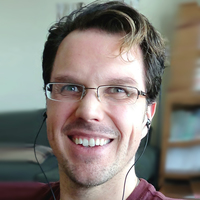


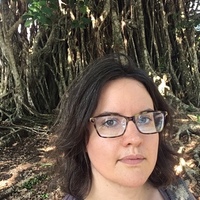




Uploads
Papers by Meow-Keong Thong